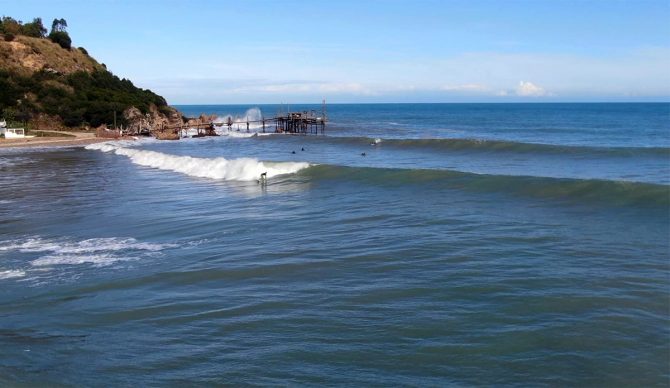
The threatened point break is the Adriatic’s finest. Photo: Fabio Ventriglia
The mayor of an Italian city thinks it isn’t a big deal to build a breakwater in front of the town’s left-hand point break because “surfing can be done anywhere.” In a country where the sport is still largely unknown to the masses, the mayor is clearly not privy to the rarity of a good point break, let alone on the Adriatic Coast.
The wave in danger is a 300-meter long left-hander called Grotta del Saraceno in the town of Vasto on Italy’s east coast. In June of last year, the city made plans and contracted out a 3.3 million-Euro job to put a series of breakwaters 40-50 meters into the sea parallel to the coastline, which would effectively turn the beach into a lagoon and destroy the wave. The purpose of the project, they say, is to mitigate erosion in the area and protect properties.
However, the local surfers, who by chance stumbled upon the municipality’s plans in September of last year, have been left puzzled and outraged by the plans. Back in February they pushed the story into national news by holding a paddle-out at the spot to protest the project. Now they’re going down the legal avenue and taking the matter to court.
“The seaside cannot be blocked, it has to move,” said Mario Trave, 47, a local surfer who has been frequenting the spot for more than two decades. “These people think that it can be stopped, but it’s not scientifically possible.”
According to Trave, the erosion in the bay is not particularly severe and there are only three properties in the bay, all of which are more than 10 meters above sea level and two of which have already been protected by near-shore breakwaters built in recent years. But the mayor says that these properties are “some of the best touristic businesses” in the area, which prompted the local government to prioritize acting on the beach’s sand flow. Previously in 2017, the Abruzzo region of Italy, in which Vasto is situated, determined that the sand dune system near the surf spot at the north end of the beach needed to be restored to control erosion, but nothing was ever done.
Drastically altering the shoreline and coastal access is business as usual in Italy. Particularly with sandy beaches, it is common practice to license out the rights of beaches to private companies that line them with umbrellas and chairs, while charging for their use. Trave estimates that more than one third of all the beaches in the country are subject to this type of ownership arrangement, and the coast-parallel breakwaters are a commonly-used method to guarantee the sand build up (and subsequent tourism profits) on such beaches.
“We are trying to demonstrate that the project is exaggerated in terms of costs and techniques involved,” said Trave. “This project will forever cancel one of the best point breaks in the Adriatic Sea and change the characteristics of this bay.”
A newly formed coalition of surfers, called Littorale Vivo, is challenging the breakwater in court. They’ve put together a crowdfunding campaign to fund their opposition of the project and resulting legal costs. They say it’s the first case of its kind in Italy – a challenge to an infrastructure project to save a wave. But they don’t expect a resolution anytime soon. As Trave points out, the legal arguments of each side and their experts could cause the legal proceedings to drag out over an extended period of time.
While the phrases “point break” and “Adriatic Sea” may seem contradictory, the unique bathymetry of Grotta del Saraceno creates the best imitation of open ocean surfing that can be found on that stretch of coast. The sea has enough fetch to create two-meter swells with periods of up to 10 seconds that peel for hundreds of meters along the sandy bay. While this type of swell is rare, Trave estimates the spot breaks about 30 days per year.
Recently, the mayor of Vasto, Francesco Menna, stoked the fire further by taking to national television to defend the project. Menna told the host that while he finds the “sea squirrels” (aka surfers) of Vasto funny, he has more important responsibilities to prioritize as mayor.
As of now, the local government hasn’t shown any inclination to listen to the surfers or collaborate on a compromise. So the fate of one of the Adriatic’s best surf spots lies in the hands of the Italian legal system. Do you think the judges in the case will know who Kelly Slater is? Or even Leo Fioravanti? A sacred point break might depend on it.

